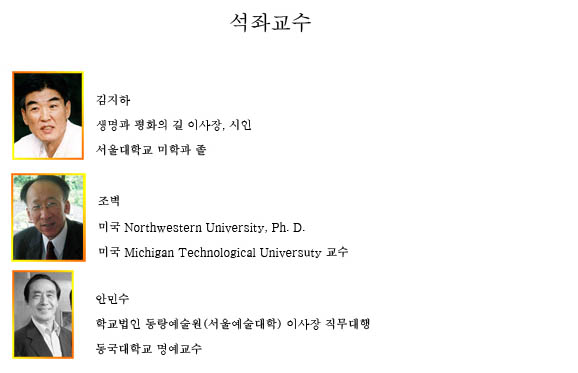16명의 신규 교원의 임용이 최종 확정됐다.학교법인 동국대학교는 지난 24일 이사회를 열고 연극학과 이윤택 교수 등 신규교원 임용을 최종 승인했다. 이번에 임용이 확정된 신규교원은 로스쿨 도입을 앞두고 법학과의 법조실무경험 교수진과 의과대 임상의학 전공 교원, 그리고 예술대학과 영상미디어 학부등의 신규교원 16명이다. 한편 이번 교원 임용에서는 시인 김지하씨와 미시간 공대 조벽 교수, 그리고 학교법인 동랑예술원 안민수 이사장을 석좌교수로 함께 임명했다. 다음은 이번에 임용된 신규교원 프로필.
 | ||
| 정용상 교수 |
- 정용상 교수
1955년 3월 10일생. 법과대학 법학과
남산기슭에 자리잡은 100년 역사와 전통을 가진 명문 동국의 품에서 연구의 나래를 틀고 동국가족의 일원이 된 것은 내 생애 가장 큰 영광이며 기쁨입니다. 저는 상법을 전공하면서, 특히 중국법을 중심으로 아시아기업관련법의 연구를 계속하고 있습니다. 향후 동국로스쿨이 중국법을 중심으로 한 아시아법연구의 메카로 우뚝 서는데 힘을 보태고 싶습니다. ‘동국’ 상표로 우리 법을 아시아에 수출하는 전사가 되고자 합니다. 동국의 명예와 자존을 지키며, 동국의 영광이 제 영광인줄 확신하며 동국중흥을 위해 올인하겠습니다. 동국만세! 만만세!! △상사법 전공 △건국대학교 법학 △건국대학교 법학 석사ㆍ박사 △부산외국어대 교수
 | ||
| 장경찬 교수 |
1954년 10월 13일 생. 법과대학 법학과
아쉬웠던 학창시설을 떠나 외부에서 배회한지 어언 25년. 새로운 천년, 젊음과의 새로운 대화 시작을 위하여 상아탑 동국대 정상에 와 주위를 무심히 살펴본다. 문득 코끼리 3마리가 다정하게 나를 응시한다. 이것은 3보(학교, 학생, 교수)가 천생연분을 갖고 한 자리에 모인 것이 아닌가.
그렇다면 우리(학교, 학생, 교수)가 할 수 있는 것은 광명이 비추는 남산을 향하여 함께 용맹하게 정진하는 것 이외 다른 그 무엇이 있겠는가, 이 곳에서. △상사법 실무 전공 △서울대학교 법학 △서울대학교 법학 석사 △성균관대학교 법학 박사 △변호사
 | ||
| 최정일 교수 |
1955년 3월 24일 생. 법과대학 법학과
먼저 제가 동국대학교에서 강의와 연구를 할 수 있게 기회를 주신 학교당국과 총장님이하 여러 교수님들께 감사를 드립니다. 또한 학교에서 자신의 꿈을 키우기 위해 열정과 이성으로써 학문에 정진하고 있는 학생여러분들께도 인사를 드립니다. 부족한 능력이지만 동국대학교와 학생 여러분들께 조금이라도 더 보탬이 될 수 있도록 열심히 공부하고, 또 열심히 가르치겠습니다. 그래서 우리들의 모교 동국에서 각 분야의 원효가 수없이 배출될 수 있도록 저의 전공법률과목에서 미력이나마 최선을 다해 작은 밑거름이 되었으면 하는 것이 저의 작은 꿈입니다. 다시 한번 동국대학교와 학생여러분들과의 새로운 인연을 가지게 된 것은 저의 삶에 있어 소중한 만남임을 말씀드리면서 이것으로 인사말씀을 갈음하고자 합니다.△법제 실무 전공 △서울대학교 정치학 △BONN 대학교 법학 석사 △서울대학교 법학 박사 △법제처 행정법제국장
 | ||
| 이현정 조교수 |
1971년 11월 2일 생. 사회과학대학 광고홍보학과
반갑습니다. 사회과학대학 광고홍보학과 이현정입니다.
안주하지 않고 발전하며 경쟁력있는 동국대학교에 일원이 된 것을 기쁘게 생각합니다. 귀한 인연이라 생각하고 우리 학생들에게 바른 role-model, 그리고 교육자가 되도록 노력하겠습니다. 우리 모두 학교에 긍정적인 힘을 실어줄 수 있고, 자신감 있는 동국인이 되도록 각자의 위치에서 최선을 다하여 최상의 결과를 볼 수 있도록 노력합시다. △광고제작 전공 △Alberta College of Art & Design Visual Communications △Pratt Institute Communication Design 석사 △한양대학교 광고홍보학 박사 △HiProject Korea Creative Director
 | ||
| 이학노 조교수 |
- 이학노 조교수
1958년 6월 10일생. 경영대학 국제통상학과
백년 전통에 빛나는 사학의 명문 동국대에서 여러분과 함께 생활하게 된 것을 매우 기쁘게 생각합니다. 동국대의 일원으로서 동국대와 동국대 가족 여러분의 발전과 성취를 위해서 저의 경험과 지식을 아끼지 않겠습니다. 동대 화이팅!
△국제통상 전공 △서울대학교 경제학 △Texas Austin 경제학 석사ㆍ박사 △산업자원부 석유산업팀장
 | ||
| 강규영 조교수 |
1968년 9월 4일 생. 생명자원과학대학 산림자원학과
또 한사람의 동국인으로서 꿈에 그리던 따뜻한 동국의 품에 안기게 된 것을 무한한 영광으로 생각합니다. 뿌리깊은 나무가 모진 비바람 속에서도 흔들리지 않고 굳건할 수 있듯이 100년의 전통을 자랑하는 우리 동국의 굵은 뿌리가 될 수 있도록 항상 노력하겠습니다.푸르른 남산의 소나무를 바라보며 동국의 희망찬 미래를 그려봅니다. △환경생태공학 전공 △동국대학교 임학 △동국대학교 임학 석사ㆍ박사 △British Columbia대 Research assistant Professor
 | ||
| 김웅섭 조교수 |
1970년 9월 2일 생. 정보산업대학 정보통신공학과
안녕하세요. 저는 미국에서 전산학의 소프트웨어 공학관련 박사학위를 한 후 삼성전자에서 핸드폰개발팀에서 일하던 중, 100년 전통의 동국대의 부름을 받아, 이번 가을학기부터 정보통신공학과에서 여러분들과 함께 하게 된 김웅섭입니다. 여러분들과 하나가 되어 동국대학교와 동국인들이 우리 사회의 중요한 부분에서 으뜸으로 우뚝설 수 있도록 최선을 다하겠습니다. △컴퓨터 및 정보통신 전 분야 전공 △서울대학교 컴퓨터공학 △University of Pennsylvania Computer & Information Science 석사 △Michigan State University Computer Science & Engineering 박사 △삼성전자 책임
 | ||
| 이윤택 부교수 |
1952년 7월 9일 생. 예술대학 연극학과
동국대 연극학과는 단순한 학과가 아닙니다. 유치진, 이해랑 선생 등이 가르침을 전한 한국 근대연극의 정통을 이어온 곳입니다. 저같이 학력이 변변찮은 사람이 한국 연극의 본산인 동국대 교수로 부임한다는 것은 대학 사회의 혁명입니다. 제가 교수가 될 수 있다는 것은 우리 사회의 학벌과 불평등이 타파되고 있다는 것을 보여주는 희망적인 조짐입니다. 또한 제가 교수로 임용된 것은 한국 공연예술계의 ‘서자가 적자가 됐다’는 것을 뜻합니다. 재야 연극인이 정통연극계에 진입한 것이고, 우리 문화의 중심과 변방의 소통, 즉 길트기가 시작됐다는 것을 의미합니다.
△연극 연출 전공 △한국방송통신대 초등교육 △극단 연희단거리패 우리극연구소 대표
 | ||
| 윤승현 조교수 |
1975년 7월21일생. 게임멀티미디어 공학과
오랜 역사와 전통의 명문사학 동국대학교의 가족이 된 것을 무한한 영광이자 커다란 기쁨으로 생각합니다. 저는 컴퓨터 공학의 응용분야인 컴퓨터 그래픽스를 공부하였습니다. 컴퓨터 그래픽스는 디지털 영상, 컴퓨터 게임 그리고 애니메이션과 같은 다양한 디지털 콘텐츠 분야의 핵심 기술에 대하여 공부하고 연구하는 분야입니다. 앞으로 동국의 학생들과 하나 되어 함께 공부하고 연구하여, 여러분이 각 분야에서 최고의 전문가가 될 수 있도록 지도하겠습니다. 또한 교육과 연구에 있어서 항상 배움에 대한 겸허한 자세로 초심을 잃지 않고 학교와 학과의 발전을 위해 최선을 다하도록 하겠습니다. △게임프로그래밍 전공 △한양대학교 수학 △서울대학교 컴퓨터공학 박사 △서울대학교 BK21 박사 후 연구원
- 문주현 조교수
1968년 10월 4일 생. 경주캠퍼스 과학기술대학
- 김병문 조교수
1960년 10월 3일 생. 경주캠퍼스 과학기술대학
- 민응기 교수
1955년 1월 30일 생. 경주캠퍼스 의과대학 의학과 임상전공
- 최종순 조교수
1971년 11월 18일 생. 경주캠퍼스 의과대학 의학과 임상전공
- 최준 교수
1948년 8.26일생. 경주캠퍼스 의과대학 의학과 임상전공
- 정보영 조교수
1974년 1월 16일 생. 경주캠퍼스 의과대학 의학과 임상전공
- 정휘수 조교수
1973년 3월 23일 생. 경주캠퍼스 의과대학 의학과 임상전공

<경주캠퍼스>

